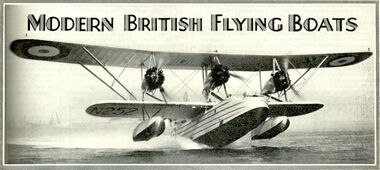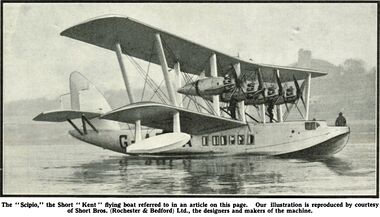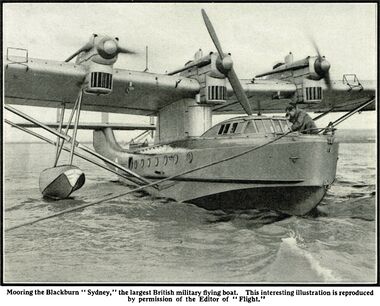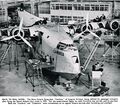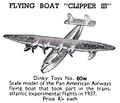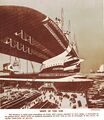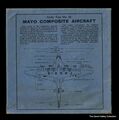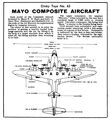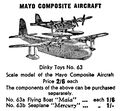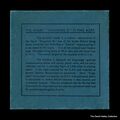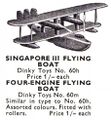Category:Flying Boats
1931: Supermarine Southampton Flying Boat [image info]
1931: "Scipio", Short S.17 Kent Flying Boat [image info]
1931: Blackburn R.B.2 Syydey Flying Boat [image info]
In the late 1920s and through the 1930s, Flying Boats were the main form factor for building large-capacity long-distance aircraft. This was partly because aerodrome runways were often still quite primitive, and could not always be guaranteed to be sufficiently long for a difficult takeoff by larger craft than the airfield had been designed for. This was especially true in "exotic" regions of the British Empire that could not be guaranteed to have runways at all. However, most populated regions were either on or near a section of coastline or a river, and had boat-docking facilities, and if a port could take boats, it could probably take flying boats.
Because of the unique engineering involved in designing a hull with sufficient buoyancy to keep the plane afloat, while also having sufficiently weak drag to allow hydroplaning, so that the craft would lift out of the water at speed, and lift completely clear for takeoff, these aircraft required elements of both boat design and aircraft design, and were regarded as a separate class of vehicle.
Contemporary commentary:
SHIPS WITH WINGS
IN no phase of flying is greater progress being made than in the construction of huge flying-boats – giant craft which are veritable ships with wings; and it is good to know that in this respect Britain is well to the fore. The machines we are developing are, in fact, in all technical respects, superior to those of any other country.
This is as it should be, remembering the importance of marine aircraft to the British Empire, with its great stretches of seas, long coastlines, and chains of islands.
The pioneer air-boats were frail machines, capable of manoeuvring only on calm water, with an ability to fly only comparatively short distances without alighting. To-day, however, Britain has giant flying boats weighing many tons, and driven by engines developing thousands ith of horse-power; and the aerial seamen who form the crews of these huge craft live on board them just as though they were in some surface craft, being provided with ample sleeping accommodation, and a kitchen in which they can prepare their meals.
In one huge air-boat built for our Royal Air Force the power-plant comprises six motors developing a total of nearly 5,000 horsepower, and the total weight of this craft is over 30 tons. In another ,achine the power-plant comprises as many as eight powerful engines.
In Germany, where experiments have been conducted with flying-boats of an exceptionally large size, one giant machine, the Dornier Do.X., holds a world's record by having risen into the air, and made a short flight, with as many as 169 people on board.
The essential feature of these new ships with wings is a long, light, slender hull, strong enough not merely to float on sheltered waters but to ride out rough waves like an ocean-going steamer. Mounted above the hull are the curved sustaining-planes and the engines and air-screws.
Our big Naval flying-boats are intended to put out to sea with the Fleet and to stay out exactly as though they were all-weather surface craft. Part ship and part 'plane, and built with light-weight metal hulls, these marine aircraft carry riding-lights, anchors, and fog-horns. They would be capable, if necessary, of remaining at sea for weeks at a time.
One interesting type of metal air-boat, the Rohrbach, can, when it alights on the water, run up two telescopic masts and set a pair of sails. Then, sailing just like a ship, it can attain a speed of five or six knots across the surface of the water. The idea is that in case of engine-failure, compelling a descent upon the sea, the flying-boat would be able to use its sails in order to reach harbour. With still bigger flying-boats, in addition to the aero-engines used in flight, it is proposed to install small marine-type motors inside the hull. These would drive under-water screws, and when on the surface the craft would be able to travel like motor-boats.
Making their resemblance to sea-going ships still more striking, some big air-boats are equipped with a small life-boat, so shaped that it fits snugly along the top of the aircraft's hull. If they need to leave their craft after some forced descent upon the water, the crew are able to launch this life-boat and row away in it with the hope of reaching the shore or being picked up by an ordinary ship.
As they float out on the water, in the open sea, flying-boats can be refuelled from tank steamers; while, in the case of the craft employed in the air-mail to South America, these come down on the surface of the ocean near their refuelling ships, and are hauled on board, being catapulted into the air again after their tanks have been refilled. It is also proposed to effect regular refuellings in mid-air. In such a case an aeroplane tanker, specially constructed, would be employed. This machine, manoeuvring above the flying-boat, and moving at the same speed, would feed down petrol through a flexible-pipe apparatus. Such a method of refuelling in the air has been proved possible in many tests by ordinary aeroplanes, but it has not yet been adopted commercially.
...
The next big phase now foreshadowed is the design and construction of mammoth marine-type aircraft far eclipsing in size anything produced hitherto. Designs have been prepared for super-giant ocean-type flying-boats; while further schemes exist for mighty triple-hulled air leviathans, driven by a regular battery of motors. In some cases it is proposed that immense winged ships, carrying several hundred people, should be driven by a special type of steam turbine. In other designs the power-plant takes the form of crude-oil engines adapted for aerial use.
— , Harry Harper, , The Wonder Book of Aircraft, 8th edition, , ~1934
During 1927 ... The boat type of seaplane underwent rapid development at this time, and large seaworthy craft such as the "Calcutta" and "Singapore," designed by Short Brothers, and the Supermarine Aviation Company's "Southampton" type were evolved.
— , M.J.B. Davy, , Interpretative History of Flight, , 1937
Subcategories
This category has the following 5 subcategories, out of 5 total.
D
- Dornier Do-X Flying Boats (1 P, 4 F)
E
- Empire Flying Boats (3 P, 6 F)
M
S
- Singapore Flying Boats (Short) (7 P, 6 F)
Pages in category ‘Flying Boats’
The following 13 pages are in this category, out of 13 total.
E
F
Media in category ‘Flying Boats’
The following 55 files are in this category, out of 55 total.
- Blackburn Iris III S1263 (MM 1931-05).jpg 3,000 × 1,946; 865 KB
- Blackburn Perth Flying Boat (WBoA 8ed 1934).jpg 3,000 × 2,255; 1.16 MB
- Blackburn Perth, Card No 35 (GPAviation 1938).jpg 2,400 × 1,254; 380 KB
- Blackburn R-B-2 N241 Sydney flying boat (MM 1931-05).jpg 3,000 × 2,416; 1.3 MB
- Blackburn RB-3A Perth Flying Boat K3581 (WBoA 8ed 1934).jpg 3,000 × 1,843; 877 KB
- Boys with Flying Boat, promotional artwork, Märklin Metallbaukasten (MarklinCat 1936).jpg 2,358 × 1,345; 1.71 MB
- Cambria, Short Empire Flying Boat (PowerSpeed 1938).jpg 3,000 × 2,668; 1.84 MB
- Canopus Empire Flying Boat G-ADHL, Imperial Airways (IHoF 1937).jpg 3,000 × 1,932; 1.37 MB
- Canopus Empire Flying Boat G-ADHL, on the Medway (PowerSpeed 1938).jpg 3,000 × 1,661; 1.08 MB
- Coriolanus, Empire Flying Boat G-AETV, Imperial Airways (PowerSpeed 1938).jpg 3,000 × 1,212; 595 KB
- Dornier Do-X Flying Boat, 1929 (IHoF 1937).jpg 3,000 × 1,932; 1.36 MB
- Dornier DoX giant flying boat (WBoA 8ed 1934).jpg 3,000 × 1,575; 930 KB
- Dornier DoX, Card No 40 (JPAeroplanes 1935).jpg 3,000 × 1,529; 699 KB
- Dornier Wal, Card No 41 (JPAeroplanes 1935).jpg 3,000 × 1,529; 716 KB
- Dornier Wal, Card No 53 (GPAviation 1938).jpg 2,400 × 1,254; 436 KB
- Empire Flying Boat, Dinky Toys 60r (MeccanoCat 1939-40).jpg 1,181 × 882; 141 KB
- Experimental Supermarine Southampton Mk X seaplane N252 (MM 1931-04).jpg 3,000 × 1,341; 747 KB
- Family scene, Imperial Airways (PowerSpeed 1938).jpg 2,051 × 3,000; 1 MB
- Flying Boat, Clipper III, Dinky Toys 60w (MeccanoCat 1939-40).jpg 1,158 × 997; 155 KB
- Future Ships of the Air (WBoA 8ed 1934).jpg 2,604 × 3,000; 1.3 MB
- Martin Clipper Flying Boat, Pan-Am (IHoF 1937).jpg 3,000 × 1,928; 1.21 MB
- Martin M-130 Clipper NC14716, Pan Am (PowerSpeed 1938).jpg 3,000 × 2,397; 1.51 MB
- Mayo Composite Aircraft, box lid (Dinky Toys 63).jpg 2,969 × 3,000; 1.69 MB
- Mayo Composite Aircraft, box lid artwork (Dinky Toys No63).jpg 2,770 × 3,000; 762 KB
- Mayo Composite Aircraft, Dinky Toys 63 (MCat 1939).jpg 1,444 × 878; 122 KB
- Mayo Composite Aircraft, Dinky Toys 63 (MM 1940-07).jpg 2,168 × 2,008; 423 KB
- Mayo Composite and Fairey Sea Fox at Felixstowe (PowerSpeed 1938).jpg 3,000 × 1,421; 919 KB
- Mayo Composite, side view (PowerSpeed 1938).jpg 3,000 × 1,540; 930 KB
- Sarafand, Short S-14 Flying Boat (WBoA 8ed 1934).jpg 3,000 × 1,898; 989 KB
- Sarafand, Short S-14 Flying Boat, over the Medway (WBoA 8ed 1934).jpg 2,095 × 3,000; 1.35 MB
- Sarafand, Short S-14 seaplane S1589 (WBoA 8ed 1934).jpg 2,146 × 3,000; 1.16 MB
- SARO Cloud, Card No 19 (GPAviation 1938).jpg 2,400 × 1,254; 391 KB
- SARO Cloud, Card No 19 (JPAeroplanes 1935).jpg 3,000 × 1,529; 635 KB
- Satyrus, Short S-17 Kent Flying Boat G-AFBC, Scipio-Class (WBoA 8ed 1934).jpg 3,000 × 2,394; 1.13 MB
- Savioa-Marchetti S-55, Card No 52 (GPAviation 1938).jpg 2,400 × 1,254; 397 KB
- Scipio, Short S-17 Kent Flying Boat G-ABFA (MM 1931-04).jpg 3,000 × 1,714; 964 KB
- Short R24-31, Card No 01 (GPAviation 1938).jpg 2,400 × 1,254; 386 KB
- Short Scion Senior VT-AHI, in Burma (PowerSpeed 1938).jpg 3,000 × 1,696; 1.14 MB
- Short Singapore III Flying Boat, box lid (Dinky Toys 60h).jpg 2,994 × 3,000; 1.46 MB
- Short Singapore III, Card No 02 (GPAviation 1938).jpg 2,400 × 1,254; 450 KB
- Short Singapore mk II Flying Boat (MM 1931-05).jpg 3,000 × 1,620; 723 KB
- Short-Mayo Composite Aircraft, jigsaw (Victory MA2).jpg 3,000 × 2,336; 1.88 MB
- Sikorsky Amphibian, Card No 38 (JPAeroplanes 1935).jpg 3,000 × 1,529; 571 KB
- Sikorsky S42, Card No 51 (GPAviation 1938).jpg 2,400 × 1,254; 414 KB
- Singapore II, Short S-12 Flying Boat N246 (WBoA 8ed 1934).jpg 3,000 × 2,312; 1.25 MB
- Singapore III Flying Boat, Dinky Toys 60h (MM 1936-06).jpg 907 × 979; 127 KB
- Singapore S-5 Flying Boat G-EBUP (WBoA 6ed 1928).jpg 3,000 × 2,291; 1.37 MB
- Southampton Flying Boat (WBoA 6ed 1928).jpg 3,000 × 1,428; 935 KB
- Supermarine Scapa, Card No 38 (GPAviation 1938).jpg 2,400 × 1,254; 471 KB
- Supermarine Seagull V - Walrus (WBoA 8ed 1934).jpg 3,000 × 2,311; 1.26 MB
- Supermarine Seagull V, Card No 03 (GPAviation 1938).jpg 2,400 × 1,270; 420 KB
- Sylvanus, Short S-17 Kent Flying Boat G-ABFB, Scipio-Class (WBoA 8ed 1934).jpg 3,000 × 2,403; 1.18 MB
- The Mayo Composite Aircraft, lineart (PowerSpeed 1938).jpg 2,359 × 3,000; 1.4 MB
